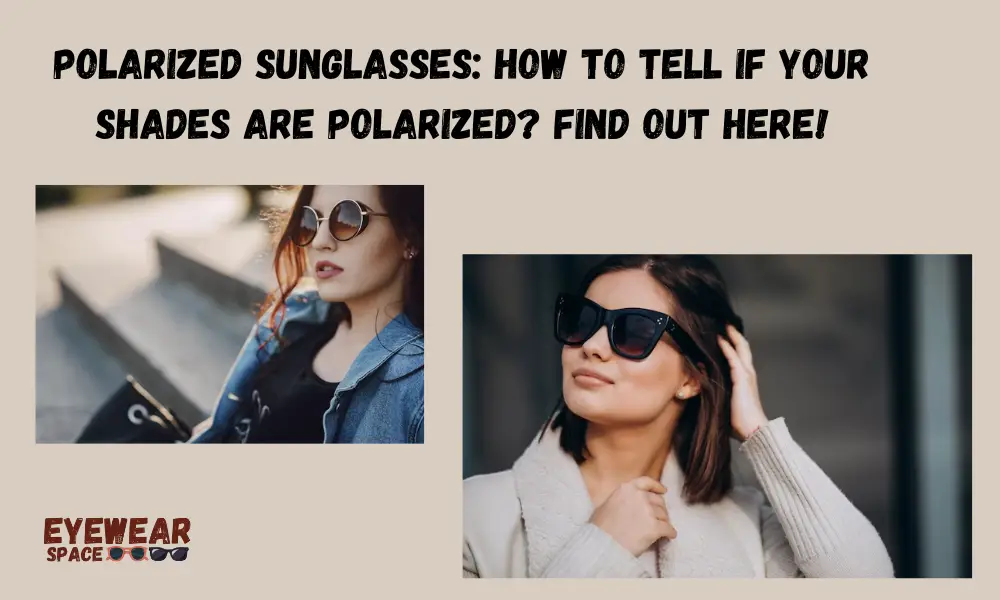When you’re looking to buy a pair of sunglasses, one of the more essential aspects of today’s market is whether or not they are polarized.
Polarized sunglasses eliminate that frustrating glare and impair vision, whether you’re in the car, strolling outside, or chilling at the beach.
It doesn’t matter whether the sun is high or low in the sky; polarized sunglasses make all the difference in your vision.
In fact, polarized sunglasses are highly advantageous in protecting your eyes every time you go out and preserving your vision in the long run, so it is advisable to wear a pair each time you face the sun.
Before putting your money down on a pair of polarized sunglasses, you should know how to tell if your glasses are actually polarized.
But how do you know if your sunglasses are polarized? Here are some easy ways to check.
How to Tell if Your Sunglasses are Polarized?

One of the quickest ways to tell if your sunglasses are polarized is simply to read out your sunglasses’ product description.
Polarized sunglasses are, of course, advertised as having polarization, so the product itself usually has test tags or stickers indicating the claim.
However, I understand that some products are misleading and contain more misinformation than others, and manufacturers know this as well.
That’s why most sunglass manufacturers selling polarized glasses include little but helpful test stickers or tags to their products to prove their claims.
Even so, counterfeits are at large in the sunglass industry that they can easily print out a fake test tag and sticker. Let’s find out if your sunglasses and the test stickers that come with them are legit by doing the following steps.
If your sunglasses are newly purchased, these test stickers are found on the lens of the sunglasses. To use this, simply hold the sunglasses horizontally and tilt them at an angle.
The sunglasses are polarized if the sticker appears darker as you tilt it. If there are no changes in the color, then it is not polarized.
Not every sunglasses manufacturer uses this trick, but it is definitely helpful for consumers for a quick and reliable test.
If your sunglasses don’t come with these test stickers or an old pair that you want to test out, you can use an LCD screen to test the polarization instead.
Hold your sunglasses in front of a lit LCD screen. You can do this in front of your computer, cellphones, iPads, or any gadget that uses an LCD screen.
After that, turn your sunglasses at a 60 to 90-degree angle and see if the lenses get darker or turn black. If they get significantly darker or they turn completely black, then your sunglasses are polarized; otherwise, they are not.
This works because LCD screens in your computer and gadgets typically use the same anti-glare technology and polarizing filter as your polarized sunglasses.
Polarized sunglasses work by blocking horizontal light waves and allowing only vertical light waves to pass through the lenses.
LCD screens work the opposite—they block out vertical light waves and emit only horizontal light waves.
As a result, the polarized lenses and the LCD screen counteracts each other; thus, you end up with a completely black or significantly dimmer vision.
You can also use this trick if you have old and tested polarized glasses lying around. Before doing this, make sure that the other pair is a hundred percent polarized; otherwise, it will spoil the result.

To do this, compare and align both of your pairs together and look at the lenses simultaneously. After that, rotate one pair of your sunglasses at an angle while keeping the other pair at a horizontal position.
If both of the glasses are polarized, then the overlapping lenses will appear darker. If nothing changes, then the sunglasses you are testing are not polarized.
Another way to test if your sunglasses are polarized is simply by assessing your view. Again, this is one of the easiest ways to test the polarization and is particularly helpful if you’re out and about outside and have no access to LCD screens.
First, find a view with a reflective surface. It may be near bodies of water, sand, or any other reflective surface where there are sun glares present. When doing this, be careful not to look at the glares directly to avoid vision impairment.
Next, hold your sunglasses horizontally and rotate them at a 60-degree angle. Observe how this affects the glares.
If the glares disappear and the lens gets darker, then rest assured your sunglasses are polarized. The sunglasses are not polarized if the glares get worse and the lens doesn’t change.
As you know, and probably one of the reasons you bought a pair of polarized glasses, polarization dramatically helps in reducing sun glares, so testing them with actual glares is one way to prove its legitimacy.
Assess your view to know if your sunglasses are polarized. When wearing them, you should be able to see a crystal clear view, no glares, and overall improved vision under bright sunny days as well as during low light conditions.
Final Words
Even though usually sunglasses are usually expensive, not all of them are created equal. Everything from different shapes and sizes to a wide range of colors can sometimes be challenging to find what you want.
With polarized sunglasses, you can be sure that you will receive the best possible degree of protection for your eyes against UV rays and glare.
If you have been wearing polarized sunglasses for a long time, then you might already be an expert in distinguishing polarized from mirrored sunglasses. And even if you’re not, the drastic difference is indeed noticeable in the naked eye.
However, sometimes, you can’t even tell if they’re polarized. If you can tell one from the other but aren’t 100% sure, you can do things to detect if they have polarized lenses, as we have mentioned above.
The methods that we have talked about are some of the foolproof ways to test the polarization of your sunglasses.
They will all give you clear-cut and reliable results, so if you’re weary and doubtful as to whether your sunglasses are actually polarized, then you can use one of these methods.

